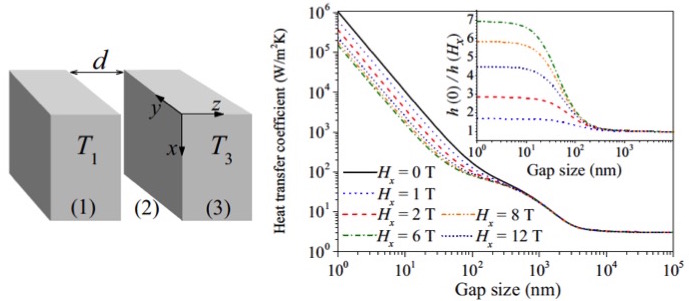The birth of thermal magnetronics
14/09/15 15:46
Radiative heat transfer is a fundamental problem of great importance in numerous areas of science and engineering. Presently, a great effort is being devoted to the investigation of the radiative heat transfer between closely placed objects. In particular, recent experiments have shown that when objects are separated by a distance smaller than the thermal wavelength (around 10 microns at room temperature), they can exchange a huge amount of heat in the form of evanescent electromagnetic waves overcoming the fundamental limit set by the Stefan-Boltzmann law for black bodies. This fact has triggered the hope that near-field radiative heat transfer could have a great impact in numerous nanotechnologies that make use of heat transfer such as heat-assisted magnetic recording, scanning thermal microscopy or thermophotovoltaics. In this context, one of the main open problems is to figure out how to actively control the near field thermal radiation.
In this work we report a detailed theoretical study of the effect of an external magnetic field in near field radiative heat transfer. We show that in a wide class of materials, namely polar and non-polar semiconductors, the application of an external field can greatly modify the radiative heat transfer providing a straightforward way to tune and modulate the near-field thermal radiation. More importantly, we show that the presence of a magnetic field radically changes the nature of the radiative heat transfer. In particular, we show that semiconductors under a magnetic field behave as ideal (and highly tuneable) hyperbolic materials. These materials are a special class of highly anisotropic optical materials that exhibit extraordinary properties such as negative refraction or subwavelength focusing and imaging, and their study is presently attracting a huge attention in the communities of metamaterials and photonics. Usually, hyperbolic materials are made of complex hybrid metamaterials whose properties are determined by the geometry and composition of the system. Amazingly, we now predict that bulk semiconductors can behave as hyperbolic materials whose properties can be easily tuned by an external magnetic field. In particular, we show that they constitute the simplest realization of near-field hyperbolic thermal emitters, a new class of emitters that is being intensively investigated from a theoretical point of view, but that it has not been yet realized experimentally. We believe that our work could change this situation.

In this work we report a detailed theoretical study of the effect of an external magnetic field in near field radiative heat transfer. We show that in a wide class of materials, namely polar and non-polar semiconductors, the application of an external field can greatly modify the radiative heat transfer providing a straightforward way to tune and modulate the near-field thermal radiation. More importantly, we show that the presence of a magnetic field radically changes the nature of the radiative heat transfer. In particular, we show that semiconductors under a magnetic field behave as ideal (and highly tuneable) hyperbolic materials. These materials are a special class of highly anisotropic optical materials that exhibit extraordinary properties such as negative refraction or subwavelength focusing and imaging, and their study is presently attracting a huge attention in the communities of metamaterials and photonics. Usually, hyperbolic materials are made of complex hybrid metamaterials whose properties are determined by the geometry and composition of the system. Amazingly, we now predict that bulk semiconductors can behave as hyperbolic materials whose properties can be easily tuned by an external magnetic field. In particular, we show that they constitute the simplest realization of near-field hyperbolic thermal emitters, a new class of emitters that is being intensively investigated from a theoretical point of view, but that it has not been yet realized experimentally. We believe that our work could change this situation.

